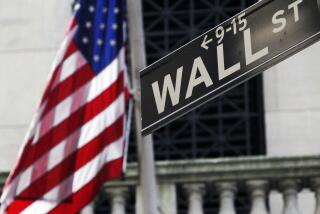Strategists’ Reputations May Ride on Next Market Turn
- Share via
Wall Street may have a lot more than usual riding on the stock market’s ability to rally--or not--from here.
Some highly publicized bullish market calls from key brokerage strategists in recent weeks strongly suggested to their clients that a market bottom was near.
Goldman Sachs’ Abby Joseph Cohen, one of Wall Street’s most influential strategists, last week told her clients to use their cash to buy stocks.
Yet that call looked costly by Monday, when the Nasdaq composite index plunged 6.3% and the Standard & Poor’s 500 dived 4.3%.
Of course, Wall Street’s guiding lights say they do not try to call short-term trends in the market. Their outlook is longer term, and they do not release reports based on day-to-day gyrations.
“We’re strategists; we are not technicians,” said Charlie Reinhard, senior U.S. equity strategist at Lehman Bros. “It’s very difficult to forecast the market bottom, and we don’t change our asset allocations every week or every month.”
Still, clients put money to work in recent weeks based on what sounded like suggestions that the end of the decline was near.
Wall Street’s No. 1-rated strategist, Edward Kerschner of UBS Warburg, told investors March 8 to boost their share of assets in stocks to 66% from 64% at his last recommendation and 57% at the beginning of the year.
Global strategists last week also turned bullish on U.S. stocks. Merrill Lynch’s David Bowers and Morgan Stanley Dean Witter’s Jay Pelosky advised clients to buy U.S. stocks after months of sharp declines, a slide prompted by concerns about the slowing economy and profit growth.
“We look at longer-term trends, and we guide investors through investment cycles,” said Reinhard, adding that he alters course based on big changes in economic and earnings data.
“The Fed easing cycle or inflation data [could change our thinking]. Earning streams could also alter allocation strategy.”
The last time Lehman changed its asset allocation was in December, when it told clients to move 20% of their investments from cash to bonds on expectations the Fed would soon lower rates.
But Reinhard is confident about Lehman’s aggressive allocation to stocks at 80% and said he will not consider changing his portfolio any time soon, believing the S&P; 500 has hit bottom or is nearly there.
Reinhard cites research showing the index touches a bottom about three months after the Fed cuts rates.
Other strategists joined Reinhard in predicting stocks are near their lows.
“I buy stocks two or three times a year and hold them for a couple of years,” said Tom Galvin, CS First Boston’s chief investment officer. “I expect to buy stocks this week. It’s a good buying opportunity.”
Galvin has maintained his aggressive allocation of 90% in stocks and 10% in cash, although he cut year-end targets on the S&P; 500, Nasdaq and the Dow to 1,520, 3,000 and 12,000 from 1,600, 4,000 and 12,650, respectively, over the last two weeks. “Technical analysis suggests that the Nasdaq can drop to 1,800, but I think we’ve done enough at this time,” Galvin said.
More to Read
Inside the business of entertainment
The Wide Shot brings you news, analysis and insights on everything from streaming wars to production — and what it all means for the future.
You may occasionally receive promotional content from the Los Angeles Times.









